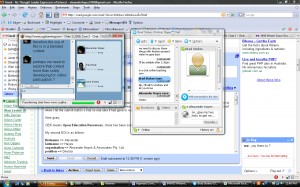
(Source: Flickr images: http://www.flickr.com/photos/mobology/2755744656/, Creative Commons License).
I recall in high school, my peers were using ICQ, a synchronous communication tool to stay connected with each other and that transitioned into MSN Live Messenger. It was mostly still text-based since the video option was a bit more grainy and unpredictable than it is now. In the past, I’ve utilized Skype to stay connected with my family and friends but more often now I use Googletalk and Gmail’s embedded live chat/video function. Also, in related news it was quite interesting to learn this week that Facebook and Skype have teamed up so that users will be able to use both applications in one interface.
In terms of the practice activity using WebCT Vista, I found it straightforward to set up a Live Classroom using the Build tab, then adding a content link into my folder. However, I was unable to access the Wimba Live Classroom/Admin link at http://wimbaclassroom.elearning.ubc.ca/launcher.cgi?room=etec565. I tried on several different web browsers and still received the error page that it couldn’t display the content.
In any case, I still found the toolkit activities useful to learn about the various third party modules that can be integrated into our Moodle sites for full audio/video conferencing. I recall that the use of Nanogong was suggested recently by one of our colleagues from the course discussion forums but to find out that there are several applications that can be used is very promising indeed. There’s everything from OpenMeetings, Dimdim, Elluminate Live, Wimba, and Marratech. It’ll be important to consider the affordances of each resource and consider how students can achieve learning objectives through the use of these tools.